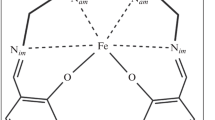Summary
The crystal and molecular structures of the ferrimagnetic bimetallic complex salt hexaamminechromium(III) hexachloroferrate(III), [Cr(NH3)6][FeCl6], have been determined from single-crystal, three-dimensional x-ray diffraction counter data. The compound crystallizes as orange coloured crystals in the space groupC2/c of the monoclinic system with Z=4 and has cell dimensionsa=11.325(1) Å,b=11.387(1) Å,c=11.233(1) Å, and β=90.83(1)Å. The structure was refined by using segmented block diagonal least-squares techniques to discrepancy indices R and Rw of 0.0233 and 0.0285, respectively. The metal ions occupy sites with symmetry\(\bar 1\) and are nearly octahedrally coordinated. In the [FeCl6]3− anion there are three independent Fe−Cl distances with a mean of 2.393(2) Å, and the maximum angular deviation from octahedral geometry is 1.20. In the [Cr(NH3)6]3+ cation, the mean of the three independent Cr−N distances is 2.079 (7) Å, and the maximum angular deviation from octahedral geometry is 0.70. The structural data provide an explanation for the observed quadrupole splitting of 0.214 mms−1 as seen in the Mössbauer spectrum at 292.6 K and reveal superexchange pathwaysvia close amine proton-chloride anion contacts with lead to 3D-ferrimagnetic ordering near 2.8 K.
Similar content being viewed by others
References
J. H. Helms, W. E. Hatfield, M. J. Kwiecien and W. M. Reiff,J. Chem. Phys.,84, 3993 (1986).
J. K. Beattie and C. J. Moore,Inorg. Chem.,21, 1292 (1982).
J. H. Zhang, W. M. Reiff, J. H. Helms, W. E. Hatfield, N. Dixon and L. Fritz,Inorg. Chem. 25, 2936 (1986).
W. E. Hatfield, R. C. Fay, C. E. Pfluger and T. S. Piper,J. Am. Chem. Soc.,85, 265 (1963).
L. Takacs and W.M. Reiff,Hyperfine Interactions,42, 1177 (1988).
W.M. Reiff,Hyperfine Interactions,40, 195 (1988).
C.K. Johnson, ORTEP-II: A FORTRAN Thermal-Ellipsoid Plot Program for Crystal Structure Illustrations, ORNL-5138, Oak Ridge National Laboratory, Oak Ridge, TN, 1976.
The intensity of the ΔM1=0 magnetic dipole transitions for the |I=1/2>⇌|I=3/2> manifold is proportional to the angular factor sin2θ where θ is the angle between the γ radiation probability (and Ho for the longitudinal case) and the easy axis of magnetization. The corresponding factor for the ΔMT=±1 transitions is 1+cos2θ. (See Greenwood, N. N. Gibb, T. C.Mössbauer Spectroscopy, Chapman and Hall: London; p. 67.)
H. Spiering,Hyperfine Interactions,5, 265 (1978).
M. J. Frisch, J. S. Binkley, H. B. Schlegel, K. Raghavachari, C. F. Melius, R. L. Martin, J. J. P. Stewart, F. W. Bobrowicz, C.M. Rohlfing, L.R. Kahn D. J. Defrees, R. Seeger, R. A. Whiteside, D. J. Fox, E. M. Fleuger and J. A. Pople,Gaussian 86, Carnegie-Mellon Quantum Chemistry Publishing Unit, Pittsburgh, PA 1984.
H. Tatewaki, Y. Sakai and S. Huzinaga,J. Comp. Chem.,2, 278 (1981).
Author information
Authors and Affiliations
Rights and permissions
About this article
Cite this article
Hatfield, W.E., Helms, J.H., Singh, P. et al. Crystal structure and mössbauer spectroscopy studies of the ferrimagnetic complex bimetallic salt hexaamminechromium (III) hexachloroferrate (III), [Cr(NH3)6][FeCl6]. Transition Met. Chem. 17, 204–208 (1992). https://doi.org/10.1007/BF02910837
Received:
Issue Date:
DOI: https://doi.org/10.1007/BF02910837




